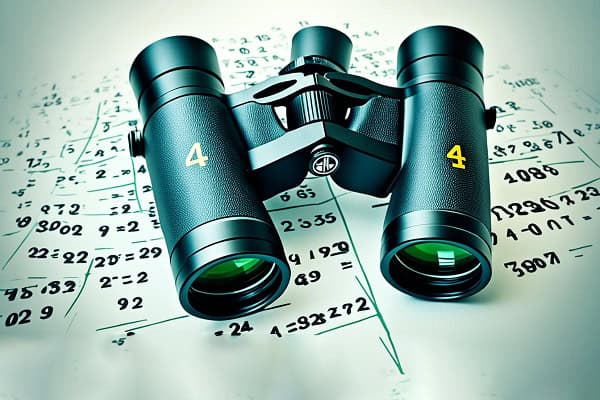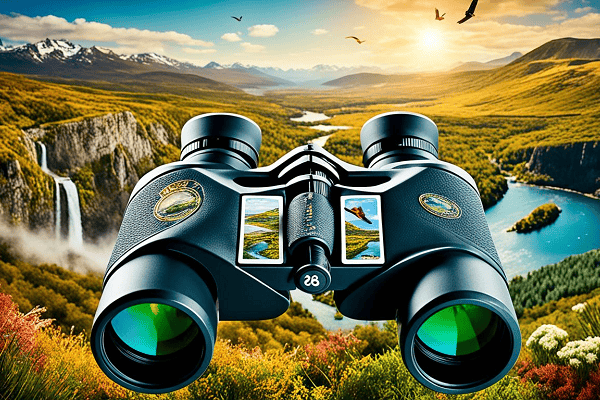What Do Binocular Numbers Mean: Expert’s Tips
Do you know What do Binocular Numbers Mean? They’re key to improving your outdoor fun, whether birdwatching, hunting, or just enjoying nature. This guide will clear up the mystery of binocular specs, like 10×42 and 8×32. By the end, you’ll know what the numbers mean and how they improve your view. Are you ready to learn the secrets of binocular numbers?
Understanding Binocular Numbers
When picking binoculars, it’s key to know the binocular numbers explained. These specs usually have two main numbers. The first number tells you the binocular magnification. For instance, a 10x pair makes objects look ten times closer than with your bare eyes.
The second number is about the objective lens diameter. It shows the size of the lens in millimeters. A bigger lens lets in more light, making images brighter and clearer. This is super useful in low light, like during dawn or dusk.
Here’s a table to help you understand these specs better:
| Specification | Meaning |
|---|---|
| Binocular Magnification (e.g., 10x) | Objects appear ten times closer. |
| Objective Lens Diameter | Size in mm that affects light-gathering ability. |
Knowing what these numbers mean helps you pick the right binoculars for your needs.
Magnification Explained
Understanding binocular magnification types is key to picking the right pair. Magnification shows how much closer an object looks compared to the naked eye. Knowing the difference between fixed and variable magnification helps you choose what you need.
Fixed vs. Variable Magnification
Binoculars are mainly fixed or variable in magnification. Fixed magnification models, like 10×42, have a set power. This makes them great for birdwatching or sports. You don’t need to zoom.
Variable magnification lets you change the power as you go. It’s like using a riflescope. This flexibility is great but can make the binoculars heavier and harder to hold steady.
Choosing the Right Magnification
Think about what you’ll be doing with the binoculars. Here are some things to consider:
- Distance: Are you looking at things far away or close by?
- Stability: Do you need a steady view, or can you handle some shaking?
- Weight: Are you okay with carrying heavier binoculars for more power?
Your choice in binocular magnification types will help you decide. Knowing if you prefer fixed or variable options can make your outdoor adventures better.
| Feature | Fixed Magnification | Variable Magnification |
|---|---|---|
| Power Adjustment | No | Yes |
| Weight | Generally lighter | Generally heavier |
| Stability | More stable | May require more handling |
| Usage | Ideal for specific tasks | Flexible for varied scenarios |
Objective Lens Diameter
The size of the objective lens is key to how well binoculars work. It affects how clear and bright your view is. Knowing about this can make your viewing better, no matter the light.
The Role of Objective Lenses
The size of the objective lens affects how much light binoculars can take in. A bigger lens means more light, making your view clearer. This is great for low light, like at dawn or dusk. When picking binoculars, think about the size to get the right brightness and clarity.
Effects of Larger Objective Lenses
Bigger objective lenses have big benefits. They let more light in, making your view brighter and clearer in dim settings. This means you see more details. Plus, they help reduce the impact of bad weather, giving you a clearer view even when it’s hazy. Choosing binoculars with large objective lenses can make your outdoor adventures better.
What Do Binocular Numbers Mean
Understanding binocular numbers is key for anyone who loves the outdoors. The numbers, like 10×42 or 8×25, tell you important things to think about when picking binoculars. The first number shows how much bigger things look, and the second shows the size of the lens in millimeters. Knowing how to read these numbers helps you choose the right pair for your needs.
Breaking Down the Numbers
Looking at binocular specs, each number means something important:
- Magnification: The first number tells you how much closer things look. For example, 10x makes things appear ten times closer than they do with the naked eye.
- Objective Lens Diameter: The second number is the size of the lens. A bigger lens, like the 42 in 10×42, lets in more light. This makes things clearer and brighter when you’re looking at them.
- Field of View: Some binoculars have a third number. This shows how much of the landscape you can see at 1,000 yards. It helps you know how much of the view you’ll get.

Understanding binocular specs can really improve your outdoor adventures. Whether you’re watching birds, hunting, or cheering at a game, knowing this info lets you pick the best gear for what you’re doing.
Field of View (FOV)
The binocular field of view (FOV) is key to how we see things. It shows the area we can see at a certain distance, like 1,000 yards. Knowing how to measure this helps you pick the right binoculars for birdwatching, hunting, or sports.
How FOV is Measured
The field of view is measured in feet or meters. It’s often shown as the area you can see at 1,000 yards wide. For instance, binoculars with a 362-foot FOV let you see a 362-foot wide area. This info is important when choosing binoculars for different activities.
Importance of a Wider Field of View
A wider FOV has many advantages, especially for fast-paced activities or watching wildlife. Some benefits include:
- Improved Tracking: Easier to follow moving subjects without losing sight.
- Enhanced Detail: Greater visibility allows for observing more details in the environment.
- Better Context: A wider FOV provides a better understanding of surroundings, crucial for wildlife observation and navigation.
Exit Pupil and Its Effect
When looking for binoculars, knowing about the exit pupil is key. It affects how much light gets through, which is crucial for seeing in the dark. Let’s explore how to calculate the exit pupil and its impact on seeing in low light.
Calculating Exit Pupil Size
To find the exit pupil, just do a simple math. Take the size of the objective lens in millimeters and divide it by the magnification. For example, with 10×42 binoculars, the exit pupil is:
| Binocular Specification | Objective Lens Diameter (mm) | Magnification | Exit Pupil Calculation (mm) | Exit Pupil Size (mm) |
|---|---|---|---|---|
| 10×42 | 42 | 10 | 42 ÷ 10 | 4.2 |
| 8×32 | 32 | 8 | 32 ÷ 8 | 4.0 |
| 12×50 | 50 | 12 | 50 ÷ 12 | 4.2 |
Influence on Low-Light Performance
The size of the exit pupil is key for seeing well in the dark. A bigger exit pupil lets more light into your eyes. This is great for activities like birdwatching in the early morning or evening.
It helps you see details you might otherwise miss. An exit pupil of 5mm or more is best for night use, making images clear and bright.
Eye Relief: A Key Factor
Choosing the right binocular numbers means understanding eye relief, especially for glasses wearers. The distance from the lens to your eye changes how you see things. Good eye relief means you see everything clearly without dark edges, making your experience better.
Why Eye Relief Matters for Glasses Wearers
For those who wear glasses, eye relief is key. Without enough relief, you might see dark edges, limiting what you can see. For comfort and clear views, look for binoculars with at least 14mm eye relief. This lets you see everything clearly without straining your eyes.
- Field of View: More eye relief means you see more of what you’re looking at.
- Comfort: Enough eye relief means you won’t get tired or uncomfortable, perfect for watching wildlife or sports.
- Adjustability: Many binoculars let you adjust the eyecups for a better fit.
| Eye Relief (mm) | Suitability |
|---|---|
| Less than 12 | Not recommended for glasses wearers |
| 12-14 | Borderline; may cause vignetting |
| 14-16 | Good for most glasses wearers |
| 16+ | Optimal comfort and visibility |
Choosing binoculars with the right eye relief makes your outdoor adventures better. You’ll enjoy exploring the world without any problems.
Close Focus Distance
Choosing the right binoculars is key if you often look at things up close. The close focus distance tells you how close you can get to an object and still see it clearly. This is vital for activities like birdwatching or macro photography, where seeing details is important.
Understanding Minimum Focus Distance
The minimum focus distance is the closest you can get to an object and still see it clearly. For instance, if your binoculars can focus on things 5 feet away, anything closer will be blurry. This is crucial for people who love to watch birds or study plants up close.
- Look for binoculars with a shorter close focus distance if you often observe small, near objects.
- Keep in mind that a longer minimum focus distance may limit your capability to spot nearby fauna or flora.
- Consider the type of wildlife or nature you want to observe when choosing the right model.

Physical Size and Weight Considerations
Choosing the right binoculars means looking at their size. The size affects how easy they are to use and carry. Smaller binoculars are great for travelers or those who use them a lot. But, bigger ones might be better for quality, even if they’re harder to carry.
Importance of Size in Binocular Selection
The size of binoculars, including their height, width, and depth, affects how you use them. Compact binoculars are easy to carry and great for outdoor activities. But, if you want the best image quality, you might choose bigger ones. Just think about how they’ll fit in your bag or pocket.
Weight Factors for Portability
The weight of binoculars is key for carrying them around. Lighter ones are perfect for hiking, birdwatching, or any adventure where you don’t want to carry a lot. Look for binoculars that are strong enough but still easy to carry. Every extra ounce can make a difference on your outdoor trips, so pick wisely.
Frequently Asked Questions
Q1: Which is better, 12×50 or 10×42 binoculars?
It depends on your needs. The 12×50 binoculars provide greater magnification, making them better for detailed viewing at a distance, while the 10×42 binoculars offer a wider field of view and are often easier to handle.
Q2: Which is better, 8×21 or 10×25 binoculars?
The 10×25 binoculars offer higher magnification, but the 8×21 binoculars provide a wider field of view and are typically easier to use for general purposes.
Q3: What does 20×50 binoculars mean?
The “20×50” indicates the binoculars have 20x magnification and 50mm objective lenses, meaning they magnify the view 20 times and the lenses are 50mm in diameter.
Q4: What does 30×60 binoculars mean?
The “30×60” signifies the binoculars have 30x magnification and 60mm objective lenses, providing a 30 times magnified view and larger lenses at 60mm.







